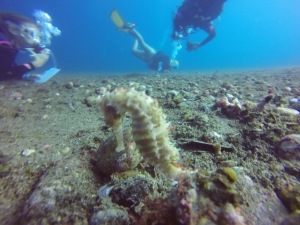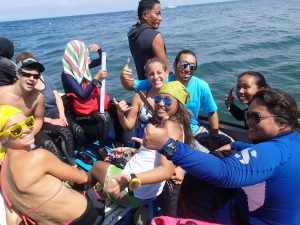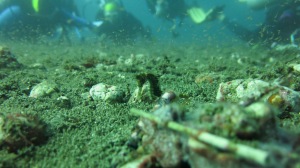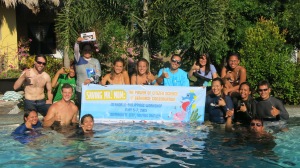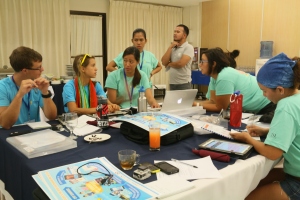Which of the following is a fish?
- Jellyfish
- Starfish
- Seahorse
- All / None / Some combination?
Surprisingly, jellyfish and starfish would be more appropriately named jellies and seastars, because both are invertebrates and therefore not fish. However, the seahorse, which evolved from a pipefish, possesses a backbone, uses a swim bladder to control its buoyancy, breathes through gills, and utilizes fins to move through the water. Therefore, unlike jellies and seastars, a seahorse is a fish! Although seahorses are clearly not your standard fish, they do not have scales and instead have an exoskeleton of hard fused plates. Their jaws are also fused making a long snout, which they use to suck up tiny fish and plankton. Seahorses possess a prehensile tail that wraps around algae or coral to anchor it to the sea floor. And finally, their eyes move independently of one another.
This past week I attended a workshop entitled, “Saving Mr. Mom: The Power of Citizen Science in Seahorse Conservation,” in Dumaguete City, Negros Oriental, Visayas, Philippines, led by iSeahorse of Project Seahorse. iSeahorse is an iPhone app that allows snorkelers, SCUBA divers, and fishermen to record seahorse sightings so that scientists can gain a better idea of seahorse population sizes and locations. On Day 1 of the conference, we learned how to identify seahorse species native to southeast Asia, which include 10 different species total and 3 species of pygmy seahorses, smaller than a fingernail in size.
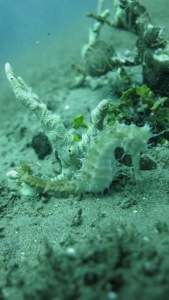
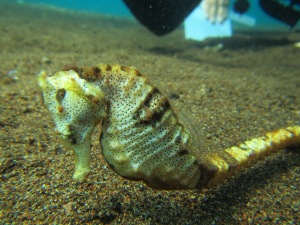
Day 2 of the workshop, was a practical application of seahorse identification skills: SCUBA diving to conduct seahorse surveys.
My group found 7 different seahorses during two dives, along with a cuttlefish and a pair of ghost pipefish. Each seahorse was measured to record torso length. Depth, habitat details, sex and pregnancy were also important observations. Most seahorses are monogamous and mate for life. Therefore, when we found a female, her male counterpart was usually not far away. Seahorse males possess a brood pouch to hold developing baby seahorses, meaning this is a case of Mr. Mom. Because the male holds growing eggs and gives birth, a female is free to collect food and devote energy to producing more eggs. However, she does visit her counterpart each day to ensure that he is properly carrying the young and to offload the next batch of eggs after he gives birth.
Day 3, was a discussion of policy regarding seahorse trade and conservation. In the province of Romblon, we hope to use sightings of rare pygmy seahorses, H. bargibanti, H. denise and H. pontohi, to expand protected ocean waters and draw tourists to the province.
Check out http://www.iSeahorse.org for more info!!

